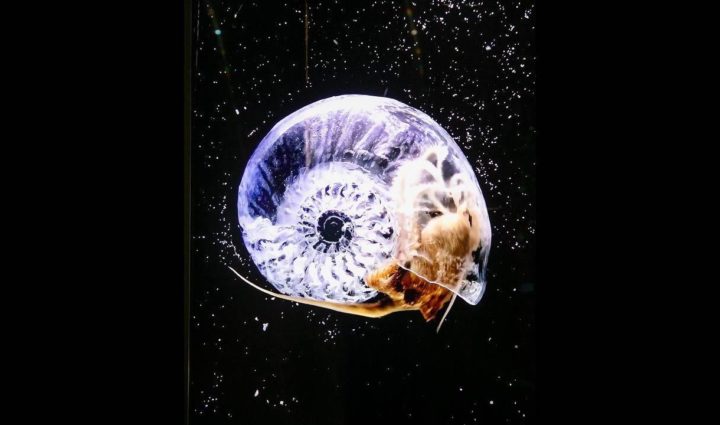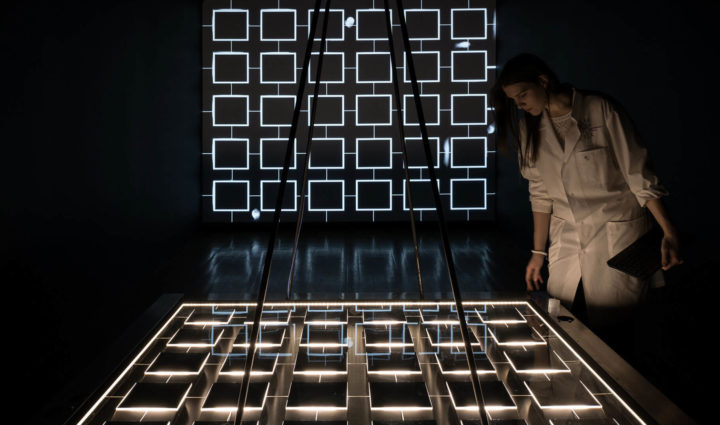The project commissioned by Laboratoria Art&Science Foundation with the support of Kaspersky Lab for the exhibition New Elements.
Between observation, meditation, material experimentation and playful action, the audiovisual installation OOZE offers an algae-altered narration about aspects of our world by investigating visual metaphors of network dynamics modulated in realtime through interaction with a living biological sculpture and the larger world.

OOZE
Theresa Schubert/Ivan Taranin (Germany)
Exhibition New Elements, Tretyakov Gallery, 2021-2022
Photo: Yuri Palmin
OOZE
Theresa Schubert/Ivan Taranin (Germany)
Exhibition New Elements, Tretyakov Gallery, 2021-2022
Photo: Yuri Palmin
OOZE
Theresa Schubert/Ivan Taranin (Germany)
Exhibition New Elements, Tretyakov Gallery, 2021-2022
Photo: Yuri Palmin
OOZE
Theresa Schubert/Ivan Taranin (Germany)
Exhibition New Elements, Tretyakov Gallery, 2021-2022
Photo: Yuri Palmin
OOZE integrates the forest as a hyperorganism with a serverfarm as a metaphor for the underlying networks of our digital and carbon lifes. 3D scans of two infrastructures of the forest and the serverfarm are controlled by the living sculpture of an algae bioreactor. Together they form a hybrid ecosystem and a techno-organic collage of a world where nature, culture and the digital continue to become increasingly intertwined, even inseparable.
The microalgae living in the installation are monitored via sensors and introduce disturbances and unpredictable events into the system—as it also happens in real life. Responding to its growth and metabolic activity, the organic interface acts as an analogue random number generator driving the images and sounds of the installation.
By shining their cellphone lights on the algae cultures, visitors help them grow and produce more oxygen, which is measured by the sensors in real time and fed as parameters into the point clouds. This allows visitors to become part of a world of computation where the digital and the natural dissolve into each other, and where human presence leaves traces and noise in the system.
Theresa Schubert about the project: At the beginning of this project was a dream. I tried to imagine how it could look or sound if non-neuronal beings like plants or algae were able to dream. What kinds of visions would they produce and how would they process reality? So I imagined what structures or entities algae would recognize as being particularly important to us humans and picked two ecosystems that enable our human lives in different ways: Forests are vital for life on Earth by purifying air, water, as habitat and to mitigate climate change. On the other hand, server farms represent our digital lives. They are the overlooked architectures holding the infrastructure of our networked lifes. They give physical presence to our digital data and make us understand that digital life has an impact on the world by using resources and contributing to climate change. I see a strong aesthetic and conceptual relation to interlink the forest as a hyperorganism and server rooms as a metaphor for our lives. The algae sculpture in the center of the installation is symbolically speaking the dream machine. It gives us an altered view of our reality and offers us a narration on how it may compute the world. It further shows how everything is connected to each other. The air we breath gives Co2 to the algae, which returns as oxygen, the light from it’s surroundings including from the video projections also stimulates the algae growth. At the same time living organisms are not binary, they can not be programmed like a computer, and even if they may be controllable, unpredictable events will always happen.













